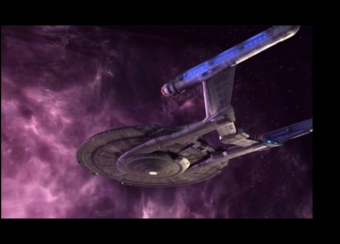
In Star Trek, a thermobaric cloud is a type of energy
formation that defined the perimeter of the Delphic Expanse. The clouds
were several million kilometers thick, and took at least six hours to
cross at sublight speeds. (ENT: "The Expanse") The thermobaric clouds
permitted entry into the Expanse, but prevented ships from leaving. The
clouds were almost certainly a product of the spheres found in the
Expanse. (ENT: "Anomaly")
The Vulcan cruiser Seleya attempted to chart the
thermobaric perimeter, but it was caught in a subspace eddy and pushed
into the Expanse. They were never heard from again, until Enterprise
(NX-01) found them adrift inside an asteroid field. (ENT: "Impulse").
When the sphere network was destroyed in early 2154, the cloud barrier
dissipated. (ENT: "Zero Hour")
Thermobaric clouds allude to the many different forms of
clouds that are found in the real universe. Among the largest of these
discovered in April 2007 - a cloud of intergalactic plasma that
stretches more than 8 million light years across - or about 80 times
the width of our galaxy in the general neighbourhood of a dense
collection of galaxies called the Coma Cluster, which lies 300 million
light years from Earth. The cloud contains several galaxy-sized black
holes.
Then there is the molecular clouds - sometimes called a
stellar nursery if star formation is occurring within. This is a type
of interstellar cloud whose density and size permits the formation of
molecules, most commonly molecular hydrogen (H2). Giant molecular
clouds (GMCs) are huge complexes of interstellar gas and dust, composed
mostly of molecular hydrogen but also containing many other types of
interstellar molecule. GMCs are the coolest (10 to 20 K) and densest
(106 to 1010 particles/cm3) portions of the interstellar medium.
Stretching typically over 150 light-years and containing several
hundred thousand solar masses of material, they are the largest
gravitationally bound objects in the Galaxy and, in fact, the largest
known objects in the universe made of molecular material. Molecular
clouds are the only places where star formation (and planet formation)
is known to occur.
There are also the Magellanic clouds, which are actually
irregular dwarf galaxies, which are members of our Local Group of
galaxies. The Large Magellanic Cloud and its neighbor and relative, the
Small Magellanic Cloud, are visbible from the Southern Hemisphere as
misty patches in the night sky, like separated pieces of the Milky Way.
Together with at least two other satellite galaxies of the Milky Way,
the Draco Dwarf and the Ursa Minor Dwarf, they move within an enormous
river of hydrogen gas known as the Magellanic Stream. The Large
Magellanic Cloud is located approximately 160,000 light-years from
Earth. It's about one-twentieth as large as our galaxy in diameter and
holds about one-tenth as many stars. The Small Magellanic Cloud is
located around 200,000 light-years from Earth. It's about ten times
smaller than its companion and a hundred times smaller than the Milky
Way.
Then there is the Solar System's Oort cloud - a
hypothetical spherical cloud of comets. The outer extent of the Oort
cloud defines the gravitational boundary of our Solar System.
The term thermobaric is derived from the Greek words for
"heat" and "pressure". The term is used today to refer to weapons and
explosives that use the gaseous products (H2, H2O, CO and CO2) of an
initial explosion for an afterburning of reactive solids. Because their
reaction with atmospheric oxygen only produces solid oxides the blast
wave is primarily generated by heat of combustion ("thermobaric")
instead of expanding explosion gases. This makes thermobaric explosives
more effective in oxygen deficient environments such as tunnels, caves
or underground bunker.
|
